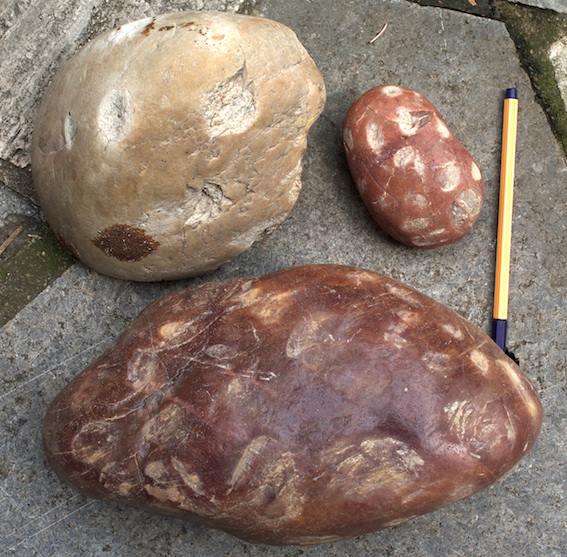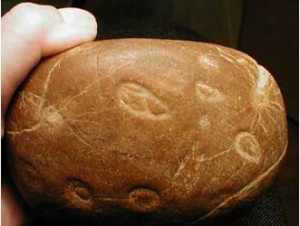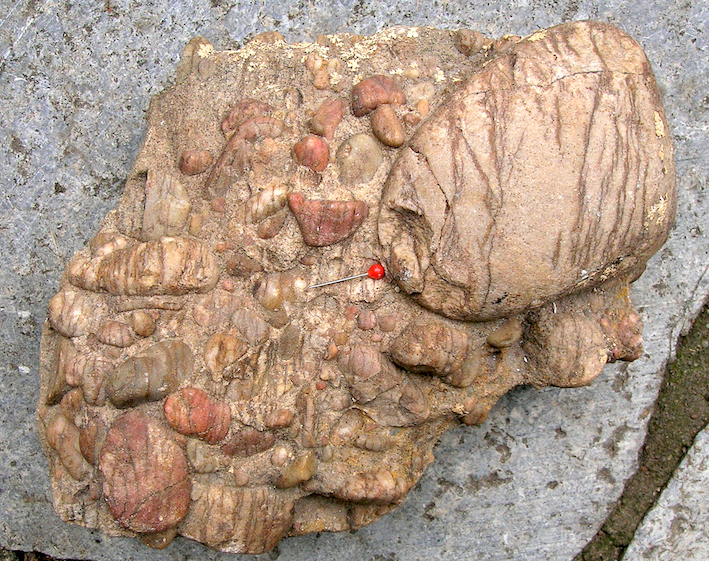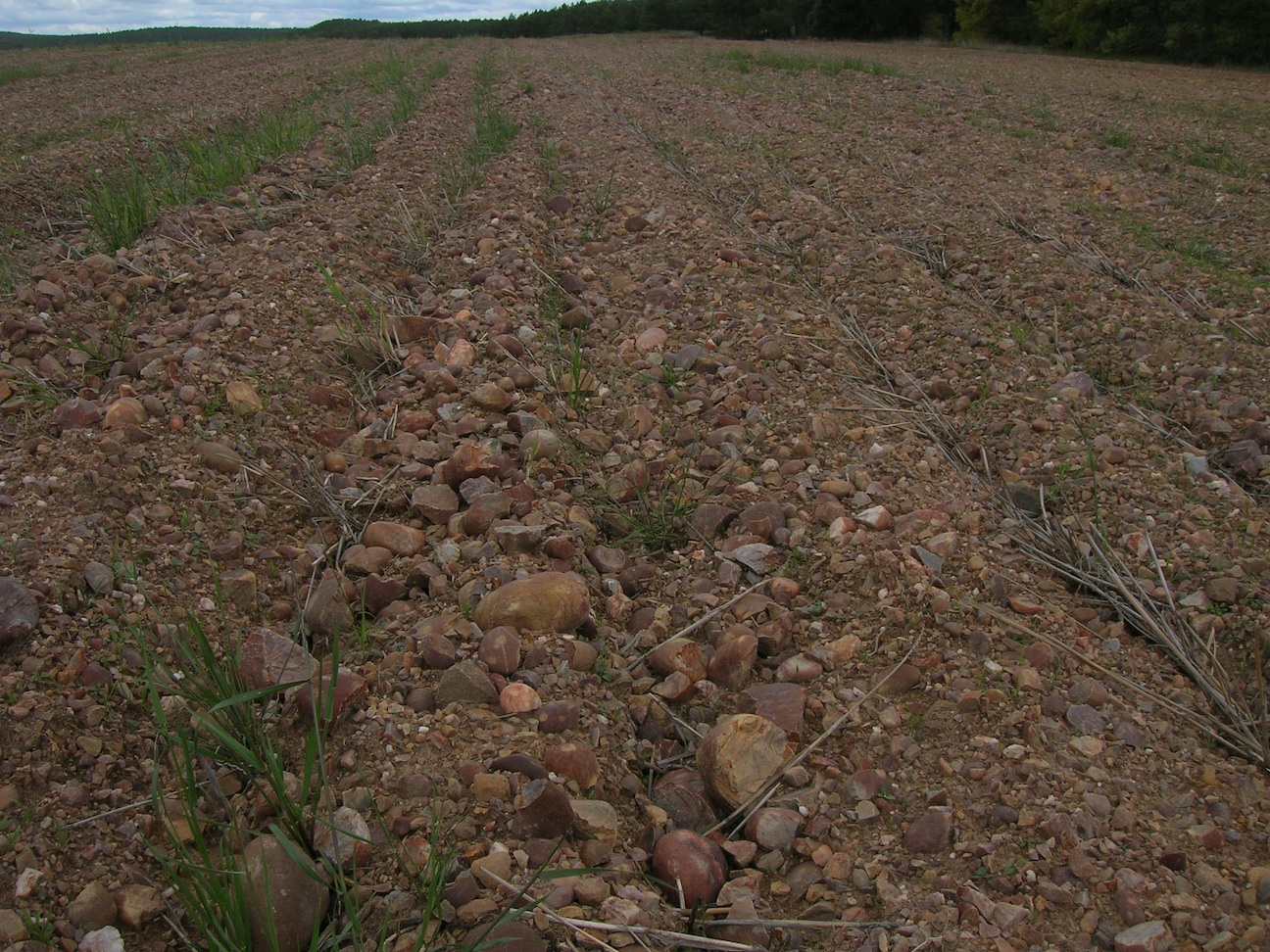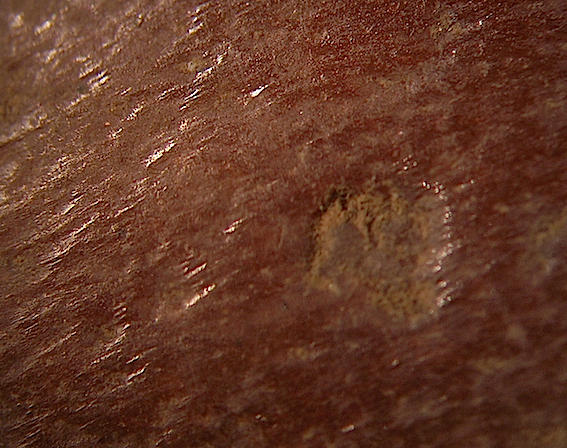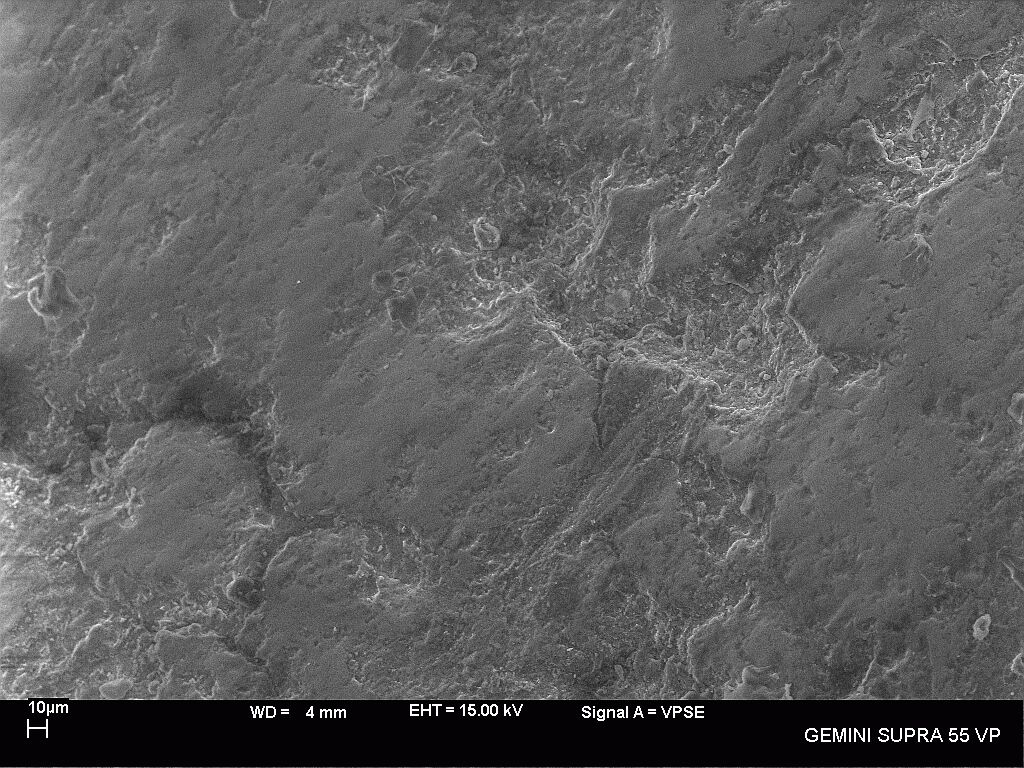by Kord Ernstson & Ferran Claudin (2012)
Shocked quartzite cobbles making up widely spread Triassic Buntsandstein conglomerates in Northern Spain have been reported (Ernstson et al. 1999, 2001) to be related to the Mid-Tertiary large Azuara multiple impact event with the formation of the Azuara impact structure and the Rubielos de la Cérida elongated impact basin (Hradil et al. 2001, Ernstson et al. 2001, 2002, Schüssler et al. 2002, Claudin & Ernstson 2003, Ernstson et al. 2003). The quartzite cobbles (and boulders) are peculiarly and intensively pockmarked and cratered (Figs. 1, 2) and show in general a closely spaced subparallel fracturing (Fig. 3). The cobbles’ characteristics become especially evident when they are found scattered in the field as a result of the conglomerate weathering (Fig. 4).
Fig. 1. Typically pockmarked, cratered and polished (the large boulder) quartzite cobbles and boulders from the Triassic Buntsandstein conglomerates.
Fig. 2. A cratered quartzite cobble. Note the concussion marks with radially diverging fractures.
Fig. 3. Closely spaced subparallel fracturing of the quartzite cobble conglomerate.
These Buntsandstein deposits are well known to geologists, they are presented in all geologic excursions to that region, and the origin of their peculiar texture from overburden pressure dissolution and tectonics has been taken for granted since decades. In their 2001(a) paper Ernstson et al. have shown that this interpretation is by no means supported by observation and can only be explained by the fact that nobody has ever studied these deformed cobbles but rudimentarily.
From detailed investigations comprising many outcrop studies, surface examinations of the cobbles including SEM imaging, numerous cuts of cobbles, microscopic thin-section inspection, shock experiments on artificial conglomerates (Ernstson et al. 2001 a), and fluid inclusion measurements (Siegert 1997) it is obvious that the common assumption of pressure dissolution and tectonic overprint has no scientific basis. Instead Ernstson et al. (2001 a) demonstrate that the peculiar features have originated from shock wave deformation which is confirmed by planar deformation features (PDFs) in quartz grains of the cobbles and by the results of the accompanying experiments. In addition to the Ernstson et al. (2001a) paper the phenomenon has lengthily been described on the www.impact-structures.com website. Nevertheless, the opposition to the results of our studies has been maintained by geologists from Spain (Cortés et al. 2002), from the Netherlands (Stel et al. 2002) and from Germany (P. Carls, pers. comm.) which is not so much surprising since they have worked considerable time in the region under discussion.
Since the beginning of our investigations of the Buntsandstein deposits and the deformed cobbles we have been aware of an intense polish off and on displayed by the quartzite cobbles, in many cases all around, and only three years ago we ran across a larger field where heavily polished quartzite cobbles of the pockmarked and cratered type were considerably enriched. (Fig. 4).
Fig. 4. Field of completely disintegrated Buntsandstein conglomerate enriched in polished quartzite cobbles and boulders. South of Molina de Aragón.
The occurrence of the scattered cobbles (and boulders) in association with reddish Buntsandstein clayey and silty material in this field strengthened our earlier idea that the polish on the cobbles’ surface must have originated from a very high confining pressure having acted in the course of the impact event, probably during a highly energetic mass flow behind the shock front. The microscopic and SEM images (Figs. 5, 6) reveal the polish to be the result of ultra-fine striation obviously by contact of the very hard quartzite rock with the very soft clayey-silty material.
Fig. 5. Polished surface of a quartzite cobble exhibiting ultra-fine striation. The width of the image is about 5 mm.
Fig. 6. A polished surface under the SEM.
Now, rather in passing we studied the polished cobble with regard to the Mohs hardness of the involved dense quartzite material. Like the mineral quartz, quartzite is commonly considered to have a Mohs hardness around 7. So, we were surprised when the heavily polished quartzite surfaces proved to be distinctly harder and could be scratched only at Mohs hardness of 8.5. In contrast, the same cobble surface outside the polished area shows Mohs hardness of regularly typical 7 or less.
Hence we conclude that the process of high-pressure polish has also led to a significant hardening of the quartzite matter the mechanism of which we don’t understand so far. Hardening by shock waves (from high explosive charge, laser shock, light gas guns) is a common technical process used to strengthen metals and alloys. In this process atomic-scale defects occur in the crystalline structure of the affected material. Possibly, a similar process may have proceeded in the surface of the shock-impinged quartzite cobbles. This is a subject of further studies we have now initiated.
Apart from the relevant and interesting mechanical behavior of the quartzite cobbles’ surfaces the effect of the obvious hardening in the course of polish yet again shows that meteorite impact seen geologically is more than the occurrence of some circular structures, the formation of shock mineral deformations and intriguing geochemical anomalies. The pockmarked, cratered and polished quartzite cobbles in the Spanish Triassic Buntsandstein conglomerates, and the permanent misinterpretation as the result of pressure dissolution and tectonics is a typical example.
References
Claudin, F. and Ernstson, K. (2003): Geologia planetaria y Geologia regional: el debate sobre un impacto múltiple en aragón. Enseñanza de las ciencias de la Tierra, vol 11, nº 3, pp 202-212.
Cortés, Angel L., Enrique Díaz-Martínez, José M. González-Casado, Marcos Aurell, Antonio M. Casas-Sainz, 2002: Cratered cobbles in Triassic Buntsandstein conglomerates in northeastern Spain: An indicator of shock deformation in the vicinity of large impacts: Comment and Reply. Geology: Vol. 30, No. 1, pp. 91–91.
Ernstson, K., Rampino, M.R., Anguita, F., Hiltl, M., and Siegert, I.: Shock deformation of autochthonous conglomerates near the Azuara impact structure, Spain: Geological Society of America Abstracts with Program, v. 31, p. A-122., 1999.
Ernstson, K., Rampino, M.R. & Hiltl, M.: Cratered of cobbles in Triassic Buntsandstein conglomerates in NE Spain: Shock deformation of in-situ deposits in the vicinity of large impacts. Geology, v. 29, no.1, 11-14, 2001 (a)
Ernstson, K., Claudin, F., Schüssler, U., Anguita, F, and Ernstson, T.: Impact melt rocks, shock metamorphism, and structural features in the Rubielos de la Cérida structure, Spain: evidence of a companion to the Azuara impact structure. Abstracts, 6th ESF IMPACT workshop, Impact Markers in the Stratigraphic record, pp. 23-24, 2001. (b)
Ernstson, K., Claudin, F., Schüssler, U., Hradil, K., 2002: The mid-Tertiary Azuara and Rubielos de la Cérida paired imapct structures (Spain). Treb. Mus. Geol. Barcelona, 11, 5-65.
Ernstson, K., Schüssler, U., Claudin, F., Ernstson, T., 2003: An Impact Crater Chain in Northern Spain. – Meteorite, 9, 35-39.
Hradil, K., Schüssler, U., and Ernstson, K.: Silicate, phosphate and carbonate melts as indicators for an impact-related high-temperature influence on sedimentary rocks of the Rubielos de la Cérida structure, Spain. Abstracts, 6th ESF IMPACT workshop, Impact Markers in the Stratigraphic record, pp. 49-50, 2001.
Schüssler, U., Hradil, K., Ernstson, K.2002: Impact-related melting of sedimentary target rocks of the Rubielos de la Cérida structure in Spain. Berichte der Deutschen Mineralogischen Gesellschaft, Beiheft 1 zum European Journal of Mineralogy, Vol. 14, S. 149.
Siegert, I. (1997): Micro-thermometric and petrographic investigations of quartzites from the Azuara-Rubielos de la Cérida doublet structure (Spain). Diploma thesis, 72 pp., Universität Bremen (in German).
Stel, Harry, Harm Rondeel, Jan Smit, 2002: Cratered cobbles in Triassic Buntsandstein conglomerates in northeastern Spain: An indicator of shock deformation in the vicinity of large impacts: Comment and Reply. Geology, 30, no 11, 1052-1052.







































































